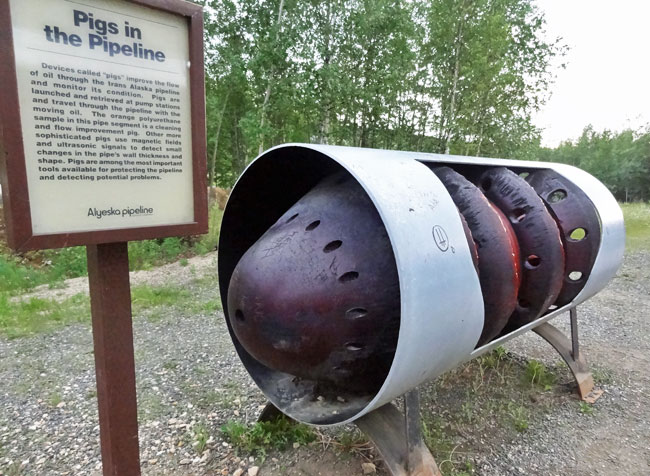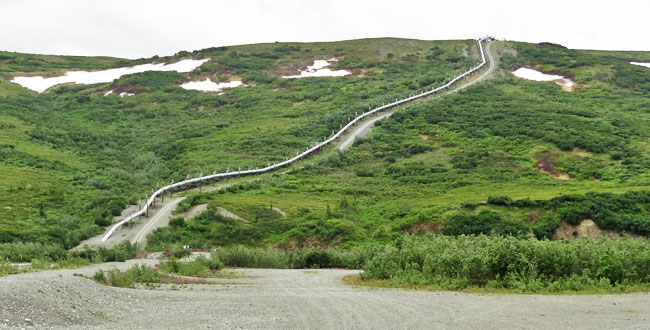
Trans Alaska Pipeline Visitor Center
Location: Fairbanks, AK
When to visit: Anytime during daylight hours (which are nearly 24 hours in summer)
Cost: Free
Time needed: 10-15 minutes
Website: Alyeska Pipeline (Wikipedia)
Back in the early ‘70s, before the subject of drilling for oil in Alaska became the highly-charged political hot-button issue it is today, the Trans Alaska Pipeline, or Alyeska Pipeline, was regarded as one of the great feats in modern engineering.
Completed in 1977, the $8 billion pipeline carries 15 percent of America’s domestic oil production. Parts of the pipeline are underground, and parts are above ground, like this portion at the Visitor Center, eight miles north of Fairbanks.
If you’re visiting Alaska, you may very well see this pipeline several times while you’re driving around.
Here’s some info about the pipeline, and what you’ll see at the visitor center.
About the Alaska Pipeline
The Alaska Pipeline is an incredible engineering feat that has been supplying oil to the United States for nearly 50 years. Spanning 800 miles from Prudhoe Bay on Alaska’s North Slope to Valdez, it transports up to 2 million barrels of crude oil daily.
The pipeline was built in response to the 1973 oil crisis, and its construction had a huge impact on the Alaskan economy.
It changed how energy is transported around the world by providing an efficient way for oil companies to move their product over long distances quickly and safely.

The visitor center has displays and pipeline maps that lay out all the facts. You can stop by anytime to learn about this structure and touch it up close.
Also on display are some of the “pigs of the pipeline,” which travel through the pipeline along with the oil and help detect any unexpected changes in the system.

How long is the Trans Alaska Pipeline?
The pipeline travels a staggering 800 miles down the entire state. While the visitor center is in Fairbanks, you can drive south for hours and see the pipeline popping up everywhere, over mountains, across rivers, through forested terrain.
I saw this lengthy section of the pipeline while completing an Alaska road trip.

The pipeline often has its own bridges as it crosses more than 500 rivers and small streams.

Oh, and this is bizarre but true: The pipeline has its own Twitter account. They tweet out the number of barrels that pass through each day, which is roughly 500,000 per day.
Want to hear another Alaska Pipeline fun fact? According to its website, “Telluric currents caused by the same phenomenon that generates the Northern Lights can be picked up by the pipeline and zinc/magnesium anodes. The anodes act like grounding rods to safety return these currents to the earth reducing the risk of damage to the pipeline.”
Even if you’re not a fan of the environmental impacts of pumping and transporting oil, seeing the Alyeska Pipeline is pretty cool, because it really is a symbol of human ingenuity.
It’s quite an architectural success to carry oil this far across the biggest state in the union.
Ready for more Alaska content? See our photo essay of Alaska pictures. Here’s a list of the best Anchorage group tours.
Here’s the story of why I visited Wrangell-St. Elias, America’s largest national park, for a mere 15 minutes. The Alaska Veterans Memorial is a worthwhile pit stop while driving between Anchorage and Fairbanks.
And here’s an in-depth look about how much an Alaska vacation costs, taking into account flights, lodging, rental car, food, and much more.
Would you consider visiting the Alaska Pipeline Visitor Center?


